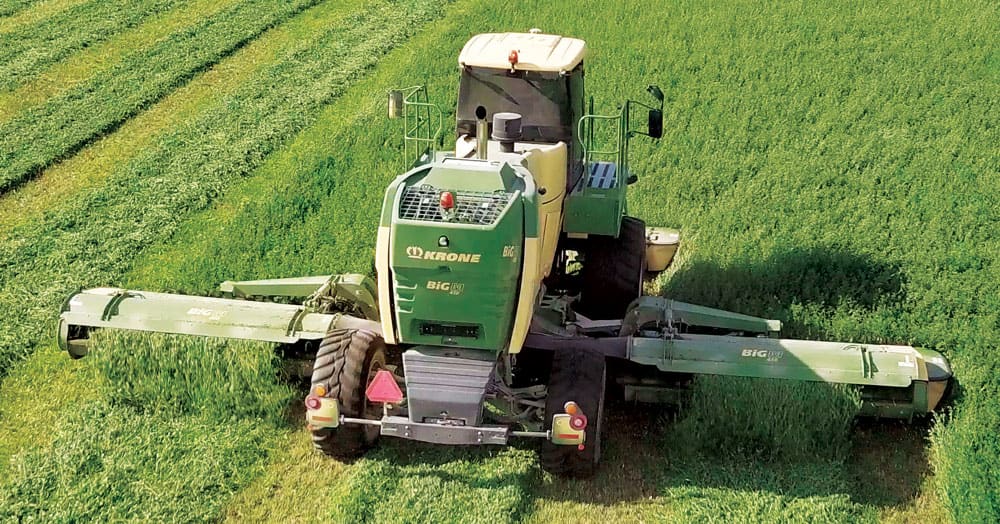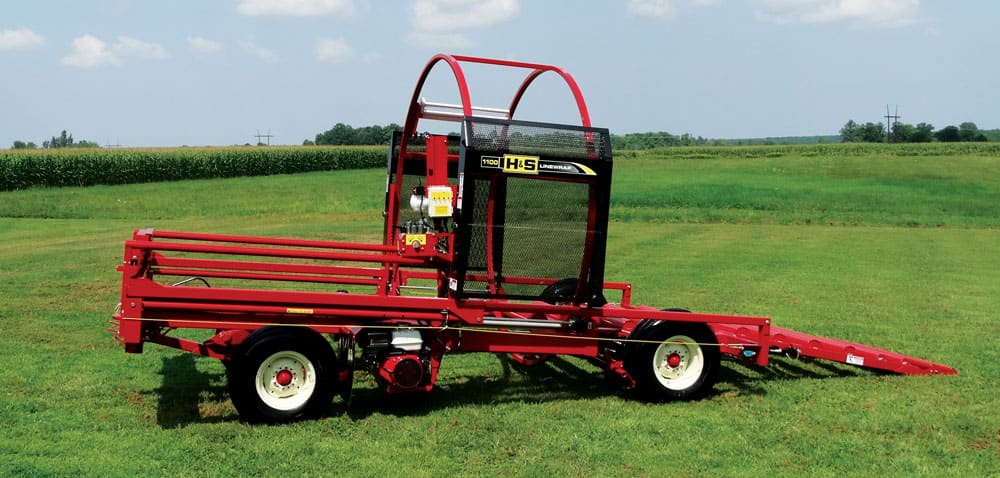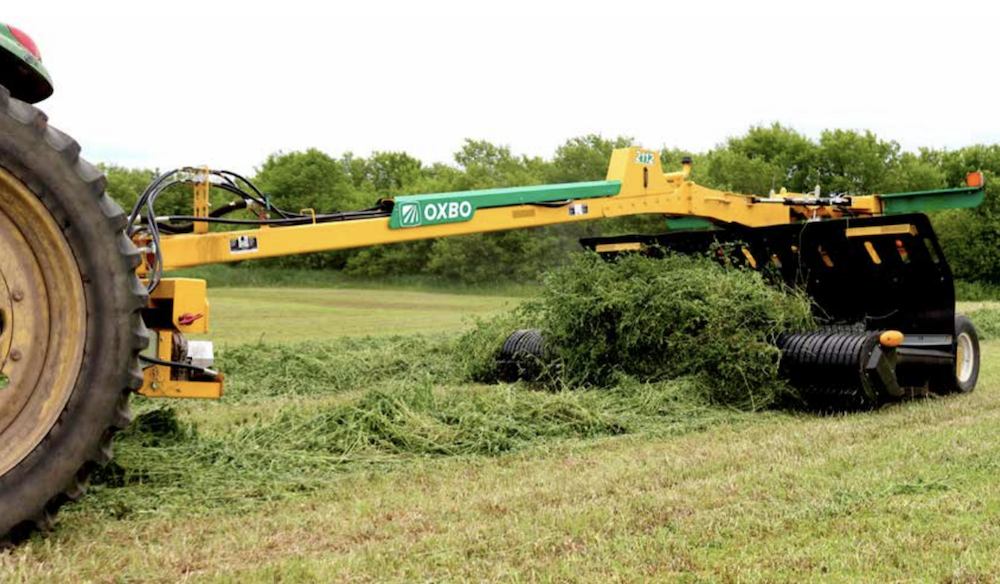For dairy farmers who have been battling poor prices in recent times, forage quality has become increasingly important. Fiber digestion rates have formed a large part of the hay quality discussion, according to Tom Kilcer, crop consultant and owner of Advanced Ag Systems. In order to increase profits, farmers feed the cows more forage which gets them producing more milk. Forage needs to be higher quality so the animal can digest it more easily. Kilcer has found that raising ash content by only a few percentage points can result in a loss of one or more pounds of milk per cow per day.
“They [equipment manufacturers] had engineering answers for the farmers questions but nobody asked the cow,” says Kilcer. “Now they’re asking the cow what she wants.”
Over the last 5-10 years, forage quality and productivity have been at the forefront of the hay industry. As this has become the trend, manufacturers have made improvements to the products used in harvesting hay. While manufacturers are focused on improving forage quality, they are also aware of a number of outside forces that can or are affecting the hay industry including the weather, market trends and consolidation.
Improving Forage Quality
As the demand for hay has been harder to reach, supply has a higher value which means producers have a greater focus on protecting their crops. Manufacturers have continued to push out improvements or entirely new products to help increase productivity, reduce ash content and protect hay. “Hay equipment is simply a means to an end,” says Dave Patterson, manager, marketing Krone-North America. “Farmers and the dealers that serve them understand you should be focused on getting the highest quality feed for that animal. That’s why forage quality is at the forefront.”
Krone’s New BiG M 450 Self-Propelled Mower Conditioner
Each year, Krone conducts research to find out the most important issues for cattle/dairy farmers when buying hay and forage equipment. Over the last few years, forage quality was at the top with return on investment right behind it, according to Dave Patterson, manager, marketing, Krone-North America.
To keep up with trends and offer the best solutions to customers, Krone has employees work with forage specialists throughout the year. “They will help train our people on the topic of forage quality more broadly,” he says. “We're not trying to make our equipment professionals experts on forage quality, but we are trying to get a good understanding of how our Krone equipment can contribute to improving overall forage quality.”
As the changing weather has become a larger issue with increased rainfall and tighter weather windows, Krone introduced its BiG M 450 self-propelled mower conditioner. This mower cuts at up to 15.5 mph with a 36-foot working width. Its new roller design allows the user to harvest sooner and have a better chance of having a higher quality forage.
The hay-in-a-day concept, coined by Kilcer, has helped to improve hay quality in recent years. In the early 2000s, the hay industry went through a shift when the concept of wide swath hay-in-a-day came out with the idea of being able to rapidly dry the crop. Before this concept, if you worked in a 2 week interval, mowing one day and chopping the next, “there was only one opportunity in that 2 week period when feed was at high quality,” says Kilcer.
Kilcer notes that while there may have only been two sunny days back-to-back, there were likely more than those consecutive sunny days throughout that two week interval in which the field could have been mowed in the morning and harvested in the afternoon with the wide swath hay-in-a-day approach. For Kilcer, the most important thing is to have whatever goes in the front of the machine come out the back at least 80% as wide. Having 80-90% cutter bar width coming out of the back of the machine maximizes the amount of sunlight hitting the hay, allowing it to dry faster, he explains.
“You’ve got to hit a point where you’ve got really good yield but you still have really good quality,” says Kilcer. “Timeliness is critical and that’s why we are moving toward the bigger machines now.”
With the introduction of wide swath hay-in-a-day, Kilcer has noted more people expressing interest in tedders. Tedders also help in speeding the drying process by fluffing up the hay. This is because with wide swath, the leaves maintain their flexibility and are not knocked off. Before this system, the outside of the windrows were extremely dry so leaves would break away.
Not only do the machines need to be bigger and more productive, they also need to keep the hay clean. Products best at keeping contaminants out of the hay include rakes and tedders. These allow the operator to go into the baler with a cleaner crop, which improves quality. Another area important to forage quality seeing increased interest is in silage bales, which farmers are attracted to because they can bale sooner while the hay is still wet, getting higher quality hay because it is wrapped tightly.
Northstar Attachments Twinstar Basket Rake
Based in Washington, Northstar Attachments manufactures hay and forage products as well as products for the orchard and vineyard market. Within the state, the No. 1 exported crop by volume is hay. The flagship product for Northstar is its Twinstar Basket Rake.
The Twinstar Basket Rake has been designed to help producers harvest cleaner hay. It has stripper bars on the baskets to help carry the hay instead of dragging it on the ground. The operator is also able to control the height of the basket and teeth to minimize contact with the ground. Optional gage wheels allow the baskets to follow field contours to also limit ground contact. Users can also control the basket speed, tilt and angles.
Over the years, Northstar has made changes to the designs of all its rakes, continuously working toward improvements to help the farmer. Going forward, the company plans to introduce a rake with several new features for the 2020 season. Northstar Attachments president Dave Rankin also says the company will continue to push for more operator friendly features.
Weather's Role
Much of the U.S. experienced a late and wet spring, the northwest experienced a late winter and flooding was a major problem for a number of states. One report indicated that two thirds of the U.S. is seeing higher rainfall than usual. “It’s to the point where it is having a detrimental impact on agriculture in one way or another,” says Craig Harthoorn, president, H&S Mfg.
Weather has always played a large part in the hay industry and its effect on how the crop is harvested also affects forage quality. With the current weather creating tighter windows, the best approach to improving forage quality is through more productive harvesting equipment that allows the farmer to get in and out of the field quicker, dry the hay faster and bale sooner.
One product manufacturers noted seeing increased interest in from customers has been bale wrappers. Since there are often not enough days in the weather window, many are looking to bale wrappers to preserve forage quality. Wrapping wet hay gives farmers control over the timing of harvest and helps in maintaining feed value. Because of this, more people are willing to pay a higher price for a bale, according to Harthoorn.
H&S Mfg. LW 1100 Linewrap Bale Wrapper
Bale wrappers have been looked at more and more by customers as rainfall has increased. In line with this demand is H&S Mfg.’s LW 1100 Linewrap Bale Wrapper. The LW 1100 can wrap round bales 4-6 feet in diameter, large square bales up to 6.6 feet lengthwise or 5 feet crosswise on the riser. It also has an automatic mode that makes it easy to use for one operator.
Weather is not a new issue the hay industry — nor the ag industry in general — has to face. The larger issue is in the tighter windows requiring a faster harvest. “Getting one good day a week is not a lot of area to work with,” says Steve Pesik, marketing manager, Oxbo. “This spring when you get a good day, it really is a scramble of people trying to get to plant and cut hay at the same time and it results in a time crunch.”
How Manufacturers are Handling Consolidation of Dairy Farms & Dealerships
Farms and dealerships continue to grow and consolidation occurs throughout the industry. There are a number of factors that play into this including retiring baby boomers who do not have family who can or will take over. Another factor is the issue of poor prices pushing dairy farmers out of business. “Unless there is an economy of scale that is able to farm a niche market that gives them a high return, it seems we’re relegating ourselves to mergers into larger and larger farming entities,” says David Rankin, president, Northstar Attachments.
According to Harthoorn, manufacturers have to be ready for these shifts and react accordingly. This includes looking at products and innovations that continue to keep pace with changing customer and dealer profiles. With all the consolidations, manufacturers have noticed an increased demand for larger machines from both dairies and dealers.
“A lot of them tend to not harvest their own crop,” says Pesik. “They have custom operators do it for them and we’re seeing businesses going to custom operations more as farm consolidate.”
Companies like Krone, Claas and John Deere are all building larger harvesters, which means that more tons of forage can be cut each day. This also means companies like H&S Mfg. are pushing out products to keep in line with the larger harvesters. For Oxbo, Pesik says the concern with these changes in the industry, namely dealership consolidation, is that they will get pushed out of dealerships because they are a smaller manufacturer.
Going forward, manufacturers are looking at products for both big and small operations. With the recent labor shortages in the farm equipment industry, some manufacturers are looking into developing products that minimize the dependency on the operator and make it easier for the farmer. Outside of tailoring to the increasing size of farming operations, manufacturers are also working on products that assist the small acreage farmer.
As customers struggle with commodity prices and other issues, manufacturers note the important role dealers can play with their customer base. Through educating themselves on the products they offer and providing their customers with the best option for their operations, dealers can contribute to the customer’s bottom line.
Oxbo 2112 Single Merger
Since 2003 with the introduction of the first Oxbo merger, Oxbo has worked with forage specialists, custom harvesters and growers to improve forage quality. With the connection between forage quality and milk production, Oxbo worked to improve its merger to provide cleaner forage. The resulting merger has been proven to provide better quality forage with lower ash content than conventional rakes and be able to handle a wider range of crops more efficiently than other mergers.
New in 2019 is the Oxbo 2112 Single Merger. “We wanted to take all the features that made our triple merger the best in the industry and apply them to a single merger for smaller operations,” says Steve Pesik, marketing manager, Oxbo. The new merger includes features such as the ability to merge left or right with a swinging chassis, skid shoes that follow the ground and the ability to gently harvest the highest quality forage.
Related Content:
Improving Hay Quality: Insights for Dealers
Wide Swath Haying Revisited
Feed Quality Demand Drives Haying Innovations











Post a comment
Report Abusive Comment